卡里美术馆
- 格式:ppt
- 大小:18.86 MB
- 文档页数:10
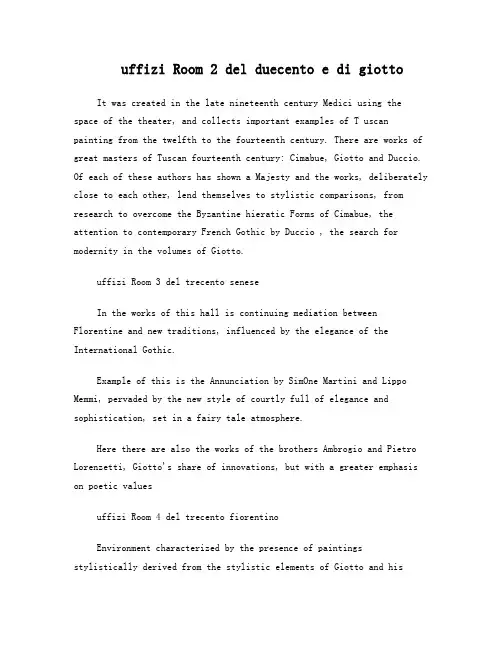
uffizi Room 2 del duecento e di giottoIt was created in the late nineteenth century Medici using the space of the theater, and collects important examples of T uscanpainting from the twelfth to the fourteenth century. There are works of great masters of Tuscan fourteenth century: Cimabue, Giotto and Duccio. Of each of these authors has shown a Majesty and the works, deliberately close to each other, lend themselves to stylistic comparisons, from research to overcome the Byzantine hieratic Forms of Cimabue, the attention to contemporary French Gothic by Duccio , the search for modernity in the volumes of Giotto.uffizi Room 3 del trecento seneseIn the works of this hall is continuing mediation betweenFlorentine and new traditions, influenced by the elegance of the International Gothic.Example of this is the Annunciation by SimOne Martini and Lippo Memmi, pervaded by the new style of courtly full of elegance and sophistication, set in a fairy tale atmosphere.Here there are also the works of the brothers Ambrogio and Pietro Lorenzetti, Giotto's share of innovations, but with a greater emphasis on poetic valuesuffizi Room 4 del trecento fiorentinoEnvironment characterized by the presence of paintingsstylistically derived from the stylistic elements of Giotto and hisworkshop, here are works by masters such as Master of St Cecilia, Bernardo Daddi, T addeo Gaddi, Andrea Orcagna, Nardo di Cione.uffizi Room 5 6 del gotico internazionaleIn this room stands the famous Adoration of the Magi by Gentile da Fabriano, built in the twenties of the fifteenth century by the merchant Palla Strozzi, the masterpiece of style courteous in Italy with the description of every detail of which is accompanied by the precious materials used. Next are the Adoration of the M agi and the Coronation of the Virgin by Lorenzo Monaco, in which the synthesis emerges between the sense of the volume of Giotto and Simone Martini's softer line, creating a rather abstract style, where nature is excluded and which is very strong mysticism. of Fra Angelico is exposed to the Thebaid, on the table by the small size of a holy hermit's life.addition there are the testimonies of the early Florentine Renaissance Anne Metterza Masaccio and Masolino, and Masaccio Madonna and Child with the same..The Adoration of the Magi is a painting by the Italian artist Gentile da Fabriano. The work, housedin the Uffizi Gallery in Florence, Italy, is considered his finest work, and has been described as "the culminating work of International Gothic painting".[1]The works shows both the international and Sienese schools' influences on Gentile's art, combined with the Renaissance novelties he knew in Florence. The panel portrays the path of the three Magi, inseveral scenes which start from the upper left corner (the voyage andthe entrance into Bethlehem) and continue clockwise, to the larger meeting with the Virgin Mary and the newborn Jesus which occupies the lowest part of the picture. All the figures wear splendid Renaissance costumes, brocades richly decorated with real gold and precious stOnes inserted in the panel. Gentile's typical attention For detail is also evident in the exotic animals, such as a leopard, a dromedary, some apes and a lion, as well as the magnificent horses and a hound.The frame is also a work of art, characterized by three cusps with tondoes portraying Christ Blessing (centre) and the Annunciation (with the Archangel Gabriel on the left and the Madonna on the right). The predella has three rectangular paintings with scenes of Jesus' childhood: theNativity, the Flight into Egypt and the Presentation at the Temple (the latter a copy, the original being in the Louvre in Paris).uffizi Room 7 del primo rinascimentoRoom filled with masterpieces of Florentine masters, contains oneof the most famous example of the Renaissance and the study on the perspective that began to affect the painters from the fifteenth century: The Battle of San Romano by Paolo Uccello, part of a triptych, now divided between the Uffizi Museum, National Gallery of the Louvre and built for Cosimo I.not less famous here are also exposed to the Dukes of Urbino by Piero della Francesca, an artist who suffered a lot of prospective studies of the timeuffizi Room 8 dei lippiFilippo Lippi and his son Filippino stand out in this room, thefirst as one of the leaders of the Florentine Renaissance with works infused with great sweetness in the figures, the latter also known to be a pupil of Sandro Botticelli and for bringing to fruition his father's style and the teacher.美丽的名作圣母圣子和众天使 1460年现藏佛罗伦萨乌菲奇美术馆圣母戴冠 1441-1444年现藏佛罗伦萨乌菲奇美术馆uffizi Room 9 dei pollaioloAntonio del Pollaiuolo, represented here by his most famous Hercules and Antaeus and Hercules and the Hydra, he focused on the movement of the figures and the constant vibration of the expressions, however, represented with a solid boundary line. Adjacent to this is also the early work by Botticelli, including Allegory of Fortitude,first reported work of the artist and dated 1470.uffizi Room 10 14 del botticelliOne of the most crowded halls of the museum because it exposes the great paintings of Botticelli's Birth of Venus and Primavera, works created in the climate of Florentine Platonism of the second half of the fifteenth century. Besides these, there are many other works by the same author as The Return of Judith from the camp of the enemy, the Minerva and the Centaur and the Adoration of the Magi.Best known is the Portrait of Man with medal Cosimo the Elder of Filippo Lippi, subject receiving increased attention For realism, probably due to the influence of Flemish art, here evidenced by the P ortinari T riptych by Hugo van der Goes.uffizi Room 15 di leonardoIn this environment you can see some of the early works of Leonardo including The Baptism of Christ, created by his teacher Verrocchio and of which he painted the angel on the left, and the Annunciation, characterized by Leonardo's sfumato.curious is the Adoration of the Magi, but the preparatory work of the state remained extremely interesting for the original composition.also in this room there are also mature works of a religioussubject of Pietro Perugino and Luca Signorelli.uffizi Room 16 delle carte geograficheHall built by Ferdinand I to house the collection of scientific instruments, is painted with maps showing the Dominion of Florence, Siena and the State of the Island of Elba. There currently are on display including some of the important paintings in the tomb Deposition by Rogier van der Weyden.uffizi Room 17 dell’ermafrod itoAlso made on the initiative of Ferdinand I, called the "Stanzino of mathematics" as used for the display of scientific instruments, iscurrently home to modern bronze sculptures and some of thearchaeological collection.uffizi tribunaEnvironment octagonal oldest part of the gallery, the T ribune has undergone many changes, but today we tried to restore its original image. Structure, decorative objects, and alluded to the four elements of the universe: air, water, earth, fire. At the center is the famous octagonal table made from semi-precious stones grand ducal workshops on a designby Jacopo Ligozzi, the side walls of some ancient statues and works of some ancient sixteenth-century Mannerist documented in this room.uffizi Room 19 del perugino e signorelliThe room has several portraits of Perugino, some works by Luca Signorelli, careful use of color to bring out tension and movement ofthe figures (For this was a model of Michelangelo), and the fanciful Piero di Cosimo, author of the Perseus freeing Andomreda emerges inwhich a debtor's atmospheric style of Filippino Lippi and Leonardo but treated with great personality.uffizi Room 20 di dürerThis room is not very large houses works by German artists who were influenced by Italian culture and mailto Florentine of the fifteenth and sixteenth centuries. Among these was the main Albrect Dürer, whosuffered particularly Italian about the prospect of innovation and the use of color realism tied to its strong Nordic-style.uffizi Room 21 del bellini e di giorgiOneOn the ceiling there is still the original decoration by Ludovico Buti depicting grotesque animals, and Indians of the New World, to witness the interests of Ferdinand I. There are preserved in particular works of the Venetian school of the fifteenth and sixteenth centuries, among which the Sacred Allegory by Giovanni Bellini.uffizi Room 22 dei fiamminghi e tedeschi del rinascimentoThe room presents an exhibition of small paintings by Germanartists such as Hans Holbein the Y ounger, Hans Memling, A ltdorfer and the Flemish.uffizi Room 23 di mantenga e correggioIn this environment, there are works by artists of the sixteenth century in northern Italy, including emerging Mantengna, considered the founder of Renaissance Lombard, and Correggio, seen by many as a forerunner of Baroque painting.uffizi Room 24 gabinetto delle miniatureOval Office, presents an extraordinary collection of miniatures from various periods and schools, representing mainly portraits and figures collected by the Medici family.uffizi Room 25 di michelangelo e dei fiorentiniHere stands the famous Michelangelo's Doni T ondo, depicting the Holy Family with St. John influenced by the work of the artist insculptural representation of volumes. Work of extraordinary importance as inspired much of Mannerist painting.uffizi Room 26 di raffaello e andrea del sartoThis room contains many works by Raphael, which testify to his artistic career from the early years of the portraits, portraits of the Dukes of Urbino, or of Francesco Maria della Rovere, who suffer from the work of the first stay in Florence in 1506, of which the Madonna of Goldfinch is best, right up to the mature works such as Portrait of Pope Leo X with his grandchildren.Space is also given to works by Andrea del Sarto, an artist influenced by the great masters of the sixteenth such as Leonardo, Michelangelo and Raphael, and attentive to the teachings of Fra Bartolomeo.uffizi Room 27 di pontormo e rosso fiorentinoThe works of these two artists testify to the evolution of painting in Florence in the sixteenth century fully directed towards a new language called Mannerism. Then there are also works by Bronzino, apupil of Pontormo, and up portrait of the Florentine court.uffizi Room 28 di tiziano e sebastiano dal piomboRoom dedicated to the Venetian painting of the sixteenth century is the greatest perFormer in Titian, which you can admire many masterpieces such as the Venus of Urbino and Flora. Also at the Venetian school canbe explained by Sebastiano del Piombo activity, very much influenced by Michelangelo and here expressed by the Death of Adonis.uffizi Room 29 del dosso e del parmigianinoParmigianino is the main artist in this room; expOnent of Emilian painting of the sixteenth century, his most famous work is the Madonna of the Long Neck, pervaded by a very elegant style and a rather complex symbology.The Madonna of the Long Neck (Italian: Madonna dal collo lungo), also known as Madonna and Child with Angels and St. Jerome, is an Italian Mannerist oil painting by the painter Parmigianino, dating from c. 1535-1540 and depicting Madonna and Child with angels. The painting was begun in 1534 for the church of the Servites in Parma,。

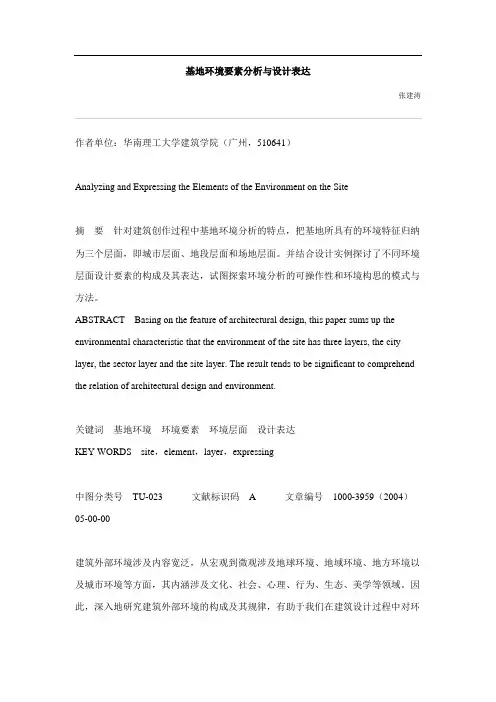
基地环境要素分析与设计表达张建涛作者单位:华南理工大学建筑学院(广州,510641)Analyzing and Expressing the Elements of the Environment on the Site摘要针对建筑创作过程中基地环境分析的特点,把基地所具有的环境特征归纳为三个层面,即城市层面、地段层面和场地层面。
并结合设计实例探讨了不同环境层面设计要素的构成及其表达,试图探索环境分析的可操作性和环境构思的模式与方法。
ABSTRACT Basing on the feature of architectural design, this paper sums up the environmental characteristic that the environment of the site has three layers, the city layer, the sector layer and the site layer. The result tends to be significant to comprehend the relation of architectural design and environment.关键词基地环境环境要素环境层面设计表达KEY WORDS site,element,layer,expressing中图分类号TU-023文献标识码A文章编号1000-3959(2004)05-00-00建筑外部环境涉及内容宽泛,从宏观到微观涉及地球环境、地域环境、地方环境以及城市环境等方面,其内涵涉及文化、社会、心理、行为、生态、美学等领域。
因此,深入地研究建筑外部环境的构成及其规律,有助于我们在建筑设计过程中对环境认知更具清晰性和条理性。
基地环境是建筑外部环境的一个组成部分,是建筑设计环境构思时制约建筑生成的重要因素。
本文针对建筑创作过程中对基地环境分析的特点,对不同环境层面要素进行分析,探讨基地环境要素的构成与设计表达,试图建构一个在建筑设计时可供分析操作的环境构思模式,以期对现代建筑创作有所裨益。
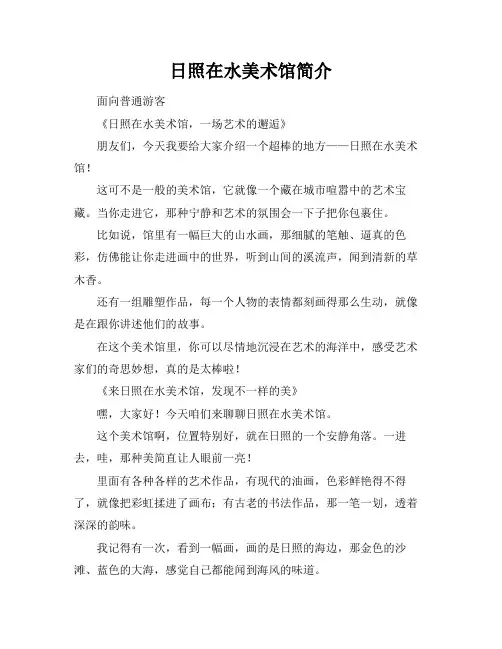
日照在水美术馆简介面向普通游客《日照在水美术馆,一场艺术的邂逅》朋友们,今天我要给大家介绍一个超棒的地方——日照在水美术馆!这可不是一般的美术馆,它就像一个藏在城市喧嚣中的艺术宝藏。
当你走进它,那种宁静和艺术的氛围会一下子把你包裹住。
比如说,馆里有一幅巨大的山水画,那细腻的笔触、逼真的色彩,仿佛能让你走进画中的世界,听到山间的溪流声,闻到清新的草木香。
还有一组雕塑作品,每一个人物的表情都刻画得那么生动,就像是在跟你讲述他们的故事。
在这个美术馆里,你可以尽情地沉浸在艺术的海洋中,感受艺术家们的奇思妙想,真的是太棒啦!《来日照在水美术馆,发现不一样的美》嘿,大家好!今天咱们来聊聊日照在水美术馆。
这个美术馆啊,位置特别好,就在日照的一个安静角落。
一进去,哇,那种美简直让人眼前一亮!里面有各种各样的艺术作品,有现代的油画,色彩鲜艳得不得了,就像把彩虹揉进了画布;有古老的书法作品,那一笔一划,透着深深的韵味。
我记得有一次,看到一幅画,画的是日照的海边,那金色的沙滩、蓝色的大海,感觉自己都能闻到海风的味道。
而且啊,美术馆的工作人员都特别热情,会给你耐心讲解每一幅作品背后的故事。
来这里逛一逛,绝对能让你的心情变得美美的!《日照在水美术馆,艺术的乐园》亲爱的朋友们,你们去过日照在水美术馆吗?如果还没有,那可真是太遗憾啦!这个美术馆就像是一个充满魔法的地方。
一进门,你会被那些精美的艺术品所吸引。
有一幅摄影作品让我印象特别深刻,拍的是一个小女孩在花丛中欢笑,那灿烂的笑容,真的能感染每一个人。
还有一些手工制作的艺术品,用的材料都是咱们生活中常见的东西,但是经过艺术家的巧手,就变成了一件件精美的宝贝。
在这里,你可以放松心情,享受艺术带来的快乐,就像在一个充满惊喜的乐园里游玩一样!《走进日照在水美术馆,感受艺术魅力》大家好呀!今天我要带你们走进日照在水美术馆。
这个美术馆不大不小,刚刚好能让你静下心来欣赏每一件作品。
比如说,有一套陶瓷作品,造型独特,上面的花纹精致极了,摸起来光滑细腻,让人忍不住想多欣赏一会儿。
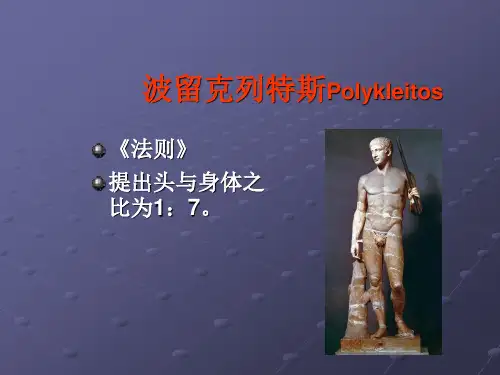
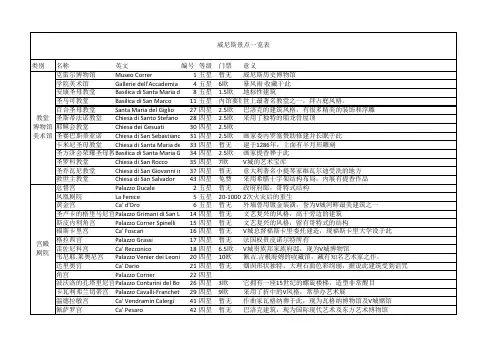

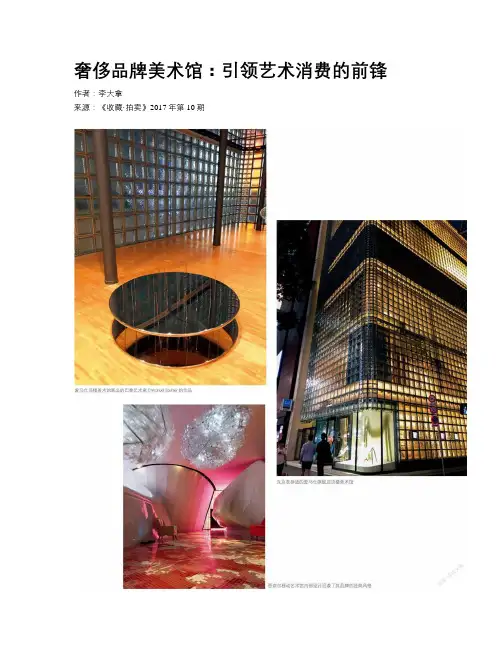
奢侈品牌美术馆:引领艺术消费的前锋作者:***来源:《收藏·拍卖》2017年第10期很多人可能不知道,LV、卡地亚、爱马仕、Prada等这些奢侈品牌都有自己的美术馆或者艺术基金会,而且比起他们卖的衣服、首饰,这些品牌的美术馆运营,要比他们的旗舰店的商品亲民得多,很多场馆的展览、表演都是免费的。
LV在北京的基金会今年夏天展出最当红的在世艺术家格哈德里希特展览的时候,不但免费还制作了精良的海报,免费送给现场来参观的人。
可惜,很多人因为并不知道这一点,凡是买不起LV的人,都把自己自行排除在可以进入的一个免费艺术展现场之外。
而LV基金会的初心,恰恰是希望能够打破人们对其只是卖衣服的爆发户的概念,让LV的形象更多元、更艺术。
奢侈品与艺术的联姻很多奢侈品品牌都把赞助艺术活动作为营销手段,LV、卡地亚、爱马仕、Prada这几大品牌不但是奢侈品的翘首,也是赞助艺术活动的大家。
他们也都在全世界各地建立了自己专属的美术馆,用以收藏自己的艺术品,作为当地的地标建筑承载自身对于艺术、时尚、戏曲等多元文化的理解。
形成这一风潮的不过几十年。
第一个进行此赞助活动的是卡地亚。
1980年,卡地亚的总裁预见到未来当代艺术将会成为社会表达的重要形式,萌生了赞助艺术展览的想法。
那时候,整个法国和欧洲都没有过这样的先例,光办手续就是一件头疼的事。
卡地亚通过公司律师奔走多年,终于在1984年成立了卡地亚当代艺术基金会,开始在全球范围内寻找具有原创性的现当代艺术品。
奢侈品品牌之所以比一般消费品在时代和历史上走得更远,并不仅仅因为他们制作出了为富人消费的高端物品,更因为他们总是在时代发生变化时,将品牌作为引导艺术消费的前锋,通过赞助和收藏艺术的形式,在自己作为前锋的作用中,变得更具有社会价值和未来意义。
Prada则是在没有建立后来的基金会和美术馆之前,从Miuccia Prada和Pafeizio bertelli夫妇成立Prada财团以来,就一直致力于购买艺术作品。
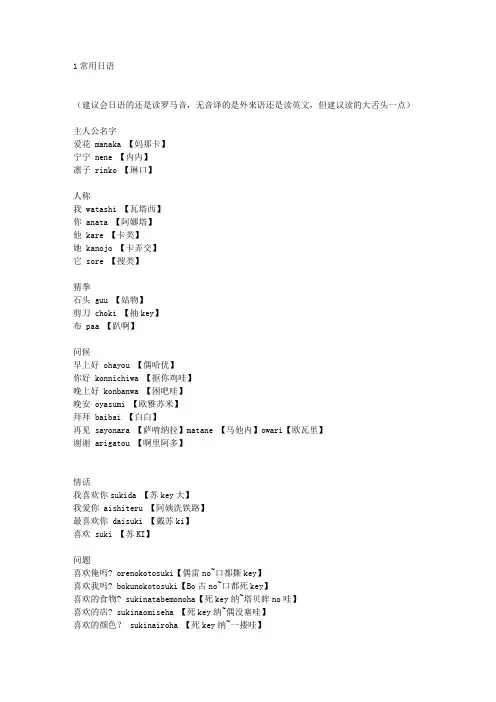
1常用日语(建议会日语的还是读罗马音,无音译的是外来语还是读英文,但建议读的大舌头一点)主人公名字爱花 manaka 【妈那卡】宁宁 nene 【内内】凛子 rinko 【琳口】人称我 watashi 【瓦塔西】你 anata 【阿娜塔】他 kare 【卡类】她 kanojo 【卡弄交】它 sore 【搜类】猜拳石头 guu 【姑物】剪刀 choki 【抽key】布 paa 【趴啊】问候早上好 ohayou 【偶哈优】你好 konnichiwa 【抠你鸡哇】晚上好 konbanwa 【困吧哇】晚安 oyasumi 【欧雅苏米】拜拜 baibai 【白白】再见 sayonara 【萨唷纳拉】matane 【马他内】owari【欧瓦里】谢谢 arigatou 【啊里阿多】情话我喜欢你sukida 【苏key大】我爱你 aishiteru 【阿姨洗铁路】最喜欢你 daisuki 【戴苏ki】喜欢 suki 【苏KI】问题喜欢俺吗? orenokotosuki【偶雷no~口都撕key】喜欢我吗? bokunokotosuki【Bo古no~口都死key】喜欢的食物? sukinatabemonoha【死key纳~塔贝眸no哇】喜欢的店? sukinaomiseha 【死key纳~偶没塞哇】喜欢的颜色? sukinairoha 【死key纳~一搂哇】喜欢的衣服? sukinafuku 【死key纳服库】现在时间? imananji 【一马那~摁鸡】说些什么 ohanashishiyo 【哦哈那希希哟】三围??? threesize体重 taichuu 【抬出】商店 misewa 【米色哇】潮流 fashion喜欢摸? skinshipwasuki 【skinship哇苏ki】喜欢KISS? kisuwasuki 【ki苏哇苏ki】颜色红 aka 【啊咔】橙 orenji 【偶凛机】黄 kiiiro 【key亿楼】绿 midori 【米豆里】蓝 ao 【啊~哦】紫 murasaki 【木拉萨key】黑 kuro 【哭罗】白 shiro 【西罗】季节喜欢XXX季节嘛?季节+wasuki 【季节+哇苏KI】春 haru【哈鲁】夏 natsu 【纳粗】秋 aki 【啊ki】冬 fuyu 【扶余】动物兔子 usagi 【屋撒寄】or【屋撒酱】狸猫 tanuki 【塔怒key】or【塔怒酱】猫 neko 【内口】or【内口酱】肯定回答是 hai【嗨】嗯 un【嗯】是呢 soudane 【搜大内】当然 mochiron 【摸其龙】来。
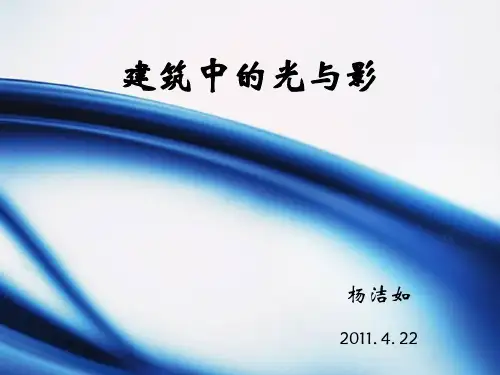

ucca沙丘美术馆简介
UCCA沙丘美术馆(UCCA Dune)是位于中国北京市延庆区
的一家当代艺术美术馆。
它是由UCCA尤伦斯当代艺术中心(Ullens Center for Contemporary Art)创办,并是其在中国境
外的第一个分馆。
UCCA沙丘美术馆建筑融入了自然风景中,位于长城脚下、金山岭长城景区附近的沙丘地貌上。
UCCA沙丘美术馆于2018年开馆,占地面积为930平方米,
室内展览面积为165平方米。
美术馆的建筑设计由德国建筑师杜立德(Li Hu)和维尔纳·索贝克(Werner Sobek)共同完成,以自然环境为基础,融合了现代建筑技术和可持续发展理念。
美术馆主要展示当代艺术作品,涵盖绘画、摄影、装置、影像等多种艺术形式。
它致力于推动当代艺术的发展和交流,并举办各类临时展览、艺术项目和艺术教育活动,旨在为观众提供与艺术作品亲密接触的机会。
UCCA沙丘美术馆以其独特的地理位置和建筑设计为人所称赞,吸引了众多国内外游客和艺术爱好者前来参观。
同时,其推动当代艺术的传播和推广也使其成为中国艺术界的重要场所之一。
金陵美术馆观后感前几天去了金陵美术馆,那可真是一场超有趣的体验,就像掉进了一个艺术的魔法世界。
一走进美术馆,那股艺术的气息就像一阵清风扑面而来。
首先映入眼帘的是各种各样的画作,它们就像一群有个性的小精灵,每一幅都在努力诉说着自己的故事。
有一幅山水画特别吸引我,那笔触细腻得就像仙女的绣花针在纸上跳舞。
山的轮廓、水的波纹,感觉就像是画家把真的山水缩小了搬到了纸上。
我站在那幅画前,仿佛能听到画里的流水潺潺声,看到山间的小松鼠在树上跳来跳去,真的太神奇了。
这让我不禁感叹画家的手简直就是马良的神笔啊。
还有一些现代艺术作品,那可就有点让人摸不着头脑了。
有一个用废旧金属拼接起来的大雕塑,看起来就像一个来自外太空的怪物。
我围着它转了好几圈,一边看一边想:“这到底是个啥呢?”不过这也正是现代艺术的魅力所在吧,它就像一个谜题,每个人都能根据自己的想法去解读。
也许在艺术家眼里,这个怪物是对现代工业社会的一种独特表达,而在我这个外行人看来,它就像是一个超级酷的外星来客,充满了神秘的科幻感。
馆里的布局也很有意思,就像一个精心设计的迷宫。
一会儿在这个小房间里看到一组色彩鲜艳的油画,像是走进了一个梦幻的童话世界;一会儿又穿过一条长长的走廊,来到一个摆满了摄影作品的展厅,感觉像是瞬间穿越到了不同的时空。
而且,在美术馆里还能看到好多不同的人。
有那些一看就是艺术行家的人,站在画前,微微点头,若有所思,好像能和画里的灵魂对话一样。
还有像我这样的普通观众,一会儿惊讶地张大嘴巴,一会儿又挠挠头表示疑惑。
大家都在这个艺术的空间里,有着自己独特的体验。
金陵美术馆就像是一个艺术的大舞台,各种各样的艺术作品在这里争奇斗艳。
它让我这个平时对艺术只是略知一二的人,也深深地感受到了艺术的魅力。
我觉得艺术这东西啊,就像一颗魔法种子,不管你是谁,只要走进这个美术馆,这颗种子就会在你的心里种下,慢慢地生根发芽,让你看到生活中不一样的美。
我已经开始期待下一次再去这个充满惊喜的地方啦。
橘园美术馆介绍
橘园美术馆是一座由日本人在中国上海建造的美术馆,于2007年2月14日正式开幕。
它的设计者是日本著名设计师伊
东丰雄,由他设计的美术馆也被称为“伊东丰雄馆”。
橘园美术馆的设计灵感来自于日本传统的建筑和绘画,它采用了最具日本特色的原木和麻绳以及玻璃作为建筑的材料。
整座建筑有着鲜明的特色,它用了大量的原木和麻绳来装饰整个建筑,同时还用了很多玻璃来营造出强烈的对比效果。
橘园美术馆一共有四层,第一层是用来展览画廊作品的地方,第二层是用来展示各类藏品的地方,第三层是用来展览小东西和纪念品的地方。
第四层则是用来举办活动和开展教育活动的场所。
橘园美术馆收藏了许多中国当代艺术大家所创作过的作品,这些作品既有齐白石、徐悲鸿、黄宾虹、林风眠等大师们晚年的佳作,也有徐悲鸿、吴冠中等人早期作品。
这些作品中既有传统写意山水,也有充满现代气息的作品。
这些作品风格迥异,内容丰富,让我们不仅可以在橘园美术馆看到大师们晚年创作中最经典、最具代表性的作品。
—— 1 —1 —。
立陶宛考纳斯美术馆的艺术收藏立陶宛考纳斯美术馆(Kaunas Art Gallery)是立陶宛最重要的艺术机构之一,也是该国最大的美术馆之一。
它位于立陶宛第二大城市考纳斯,坐落在一个历史悠久的建筑中,为游客们提供了一个探索立陶宛艺术和文化的独特机会。
立陶宛考纳斯美术馆的艺术收藏是其最引人注目的特点之一。
这个收藏涵盖了从中世纪到当代的各种艺术形式,包括绘画、雕塑、摄影、装置艺术等。
其中最重要的部分是立陶宛艺术家的作品,这些作品展示了立陶宛艺术的发展和变化。
在考纳斯美术馆的收藏中,有一些特别有名的作品。
其中之一是来自19世纪的画家米卡罗尼斯·科纳斯的作品。
科纳斯是立陶宛最著名的画家之一,他的作品以其独特的风格和对立陶宛民俗的描绘而闻名。
考纳斯美术馆的收藏中展示了他的许多作品,包括《农民的婚礼》和《立陶宛人的家庭》等。
除了科纳斯的作品,考纳斯美术馆的收藏还包括其他立陶宛艺术家的作品,如弗拉基米拉斯·奥克斯塔斯·米卡尔斯基斯和米兰达·马尔尼特。
这些艺术家的作品展示了立陶宛艺术在20世纪的发展,并呈现出不同的风格和主题。
此外,考纳斯美术馆还展示了一些国际艺术家的作品,为观众们提供了一个更广阔的视野。
这些作品来自世界各地的艺术家,包括维克多·瓦萨雷利、安德里亚·泽伊特斯和奥斯卡·尼埃米耶尔等。
这些作品通过不同的艺术形式和风格,向观众展示了不同文化之间的对话和交流。
除了永久收藏,考纳斯美术馆还定期举办临时展览,以展示更多的艺术作品和主题。
这些展览通常与当代艺术和社会问题有关,旨在引发观众对艺术和社会的思考。
通过临时展览,考纳斯美术馆不仅向观众展示了多样化的艺术作品,还提供了一个平台,让艺术家们可以表达他们对当代社会问题的看法。
除了艺术收藏和展览,考纳斯美术馆还定期举办各种艺术活动和教育项目。
这些活动包括艺术家讲座、工作坊和导览等,旨在增加观众对艺术的了解和欣赏。
参观美术馆日记400字第一篇:美术馆日记400字今天,我参观了宁波市美术馆,那里有五个展厅,分别是中央厅、2号展厅、3号展厅、4号展厅和多功能厅,还有一个长廊和售票处。
中央厅有一个巨大的电视,中央厅中央放着一个宁波市区的模型,上面有宁波市的所有区县。
2号展厅里有宁波市的发展,还有一个可以踩的地毯,上面全是树叶,踩上去树叶会散开,当全部散开时,上面会出现一座桥,而且当叶子全部散开之后,没几秒叶子又会重新聚拢。
3号展厅里有宁波市区县的发展,有江东区、江北区、海曙区、北仑区、镇海区、鄞州区、宁海县、象山县、余姚市、慈溪市等,那边也有一个可以踩的地毯,这回不一样,是一个池塘,不时会有鱼游过来,用脚踩就可以把鱼赶走,恢复原来的池塘。
4号和多功能展厅还没有开放,所以我没去看。
除此之外,我还看了西藏唐卡的一些佛像画,这就是美术馆的全部内容,有兴趣你也可以去看看。
第二篇:美术馆日记400字今天,我参观了宁波市美术馆,那里有五个展厅,分别是中央厅、2号展厅、3号展厅、4号展厅和多功能厅,还有一个长廊和售票处。
中央厅有一个巨大的电视,中央厅中央放着一个宁波市区的模型,上面有宁波市的所有区县。
2号展厅里有宁波市的发展,还有一个可以踩的地毯,上面全是树叶,踩上去树叶会散开,当全部散开时,上面会出现一座桥,而且当叶子全部散开之后,没几秒叶子又会重新聚拢。
3号展厅里有宁波市区县的发展,有江东区、江北区、海曙区、北仑区、镇海区、鄞州区、宁海县、象山县、余姚市、慈溪市等,那边也有一个可以踩的地毯,这回不一样,是一个池塘,不时会有鱼游过来,用脚踩就可以把鱼赶走,恢复原来的池塘。
4号和多功能展厅还没有开放,所以我没去看。
除此之外,我还看了西藏唐卡的一些佛像画,这就是美术馆的全部内容,有兴趣你也可以去看看。
第三篇:美术馆日记400字和老师与同学参观美术馆,步入美术馆的第一秒起,那场面旧深深震撼着我。
首先映入眼帘的是各种各样的人:金发的、黑发的、棕发的;蓝眼珠的、绿眼珠的、纵眼珠的;高的、矮的、胖的、瘦的……简直像“人种展览会”。